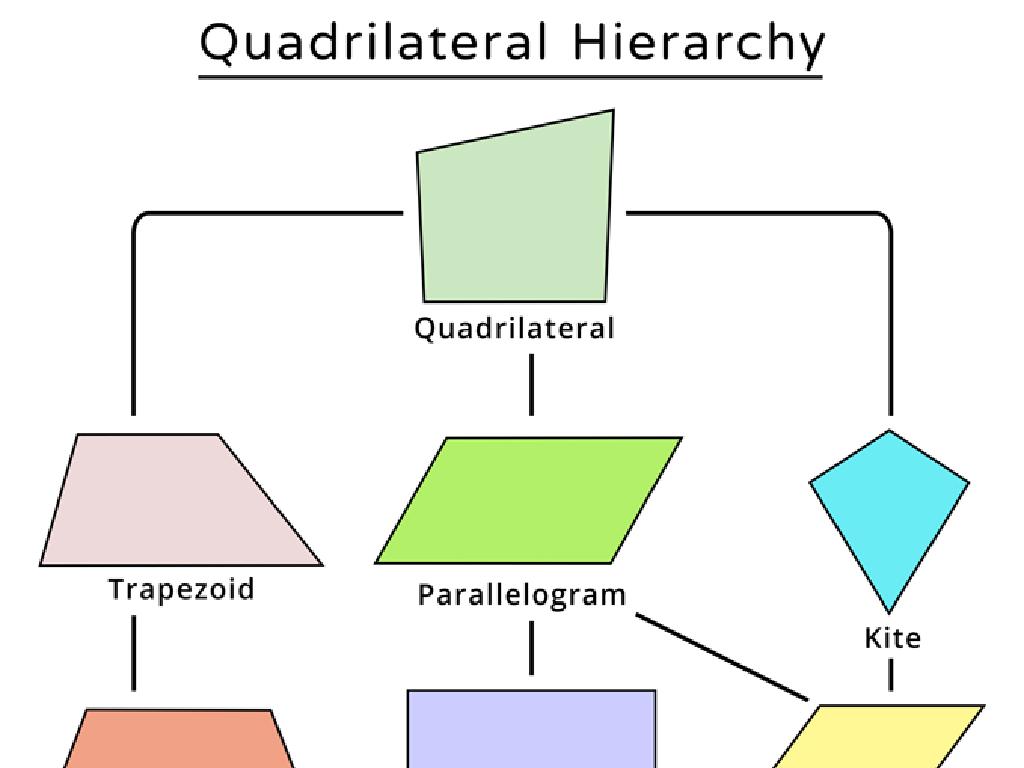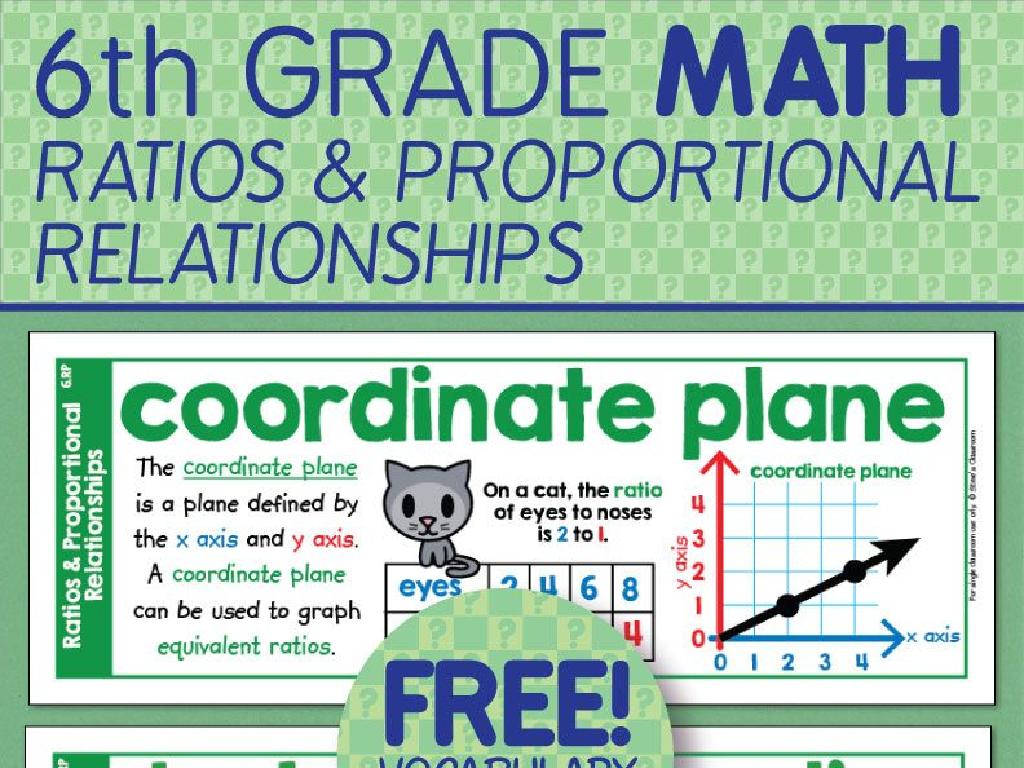Find Two Numbers Based On Sum And Difference
Subject: Math
Grade: Third grade
Topic: Mixed Operations: Addition And Subtraction
Please LOG IN to download the presentation. Access is available to registered users only.
View More Content
Today’s Math Adventure: Finding Two Numbers!
– Explore mixed operations
– Addition and subtraction basics
– Adding combines numbers; subtraction takes one number away from another
– Daily life applications
– Use these operations for tasks like shopping or sharing snacks
– Activity: Find two numbers
– Use clues about their sum and difference to find the mystery numbers
|
This slide introduces the concept of mixed operations, focusing on addition and subtraction, to third-grade students. Begin by explaining that mixed operations involve both adding and subtracting numbers. Then, break down the basics of addition as combining two or more numbers to make a new total, and subtraction as finding the difference when one number is taken away from another. Illustrate how these operations are used in everyday life, such as totaling the cost of items when shopping or dividing treats among friends. Conclude with an engaging class activity where students use given sums and differences to figure out the two original numbers, enhancing their problem-solving skills and understanding of the relationship between addition and subtraction.
Recap: Addition and Subtraction
– Review: What is addition?
– Addition means putting numbers together.
– Review: What is subtraction?
– Subtraction means taking one number away from another.
– Relation between addition & subtraction
– If we know the sum and difference, we can find the original numbers.
– Finding numbers using both
– Example: Sum is 10, difference is 2, the numbers are 6 and 4.
|
Begin with a quick recap of addition as the process of combining numbers to find a total. Then, explain subtraction as the method of finding the difference when one number is taken away from another. Highlight how these operations are inverses of each other, using simple examples. For instance, if we add 3 and 2 to get 5, then subtracting 2 from 5 will give us back 3. Emphasize that understanding this relationship is key to finding two numbers when we know their sum and difference. Provide a clear example, such as if the sum of two numbers is 10 and their difference is 2, the numbers are 6 and 4 because 6+4 equals the sum (10), and 6-4 equals the difference (2). This will set the stage for more complex problems and ensure a solid understanding of these foundational concepts.
Understanding Sum and Difference
– Sum: Adding two numbers together
– If you have 3 apples and get 2 more, your sum is 3 + 2 = 5 apples.
– Difference: Subtracting one number from another
– If you have 5 apples and give away 2, your difference is 5 – 2 = 3 apples.
– Real-life examples of sum and difference
– Buying items: total cost (sum) or change received (difference).
– Solving for numbers using sum and difference
– Find two numbers if their sum is 10 and difference is 4: numbers are 7 and 3.
|
This slide introduces the basic concepts of sum and difference, which are foundational in understanding arithmetic operations. Start by explaining that the sum is the total you get when you add two numbers together. For difference, it’s what you have left when you subtract one number from another. Use relatable examples like combining or separating objects to illustrate these concepts. Then, show how these operations can be applied in real-life situations, such as shopping. Finally, demonstrate how to find two specific numbers when their sum and difference are known, which is a practical application of these concepts in problem-solving.
The Mystery of Numbers: Using Sum and Difference
– Understand sum and difference
– Sum is when we add two numbers together
– Clues to find two numbers
– Difference is when we subtract one number from another
– Example: Sum is 10, difference is 2
– What two numbers add up to 10 and when subtracted, equal 2?
– Solving the mystery numbers
– Let’s find the two mystery numbers together!
|
This slide introduces the concept of finding two numbers when their sum and difference are known. Start by explaining that the sum is the result of adding two numbers, while the difference is the result of subtracting them. Use the example provided to illustrate how to apply this knowledge: if the sum of two numbers is 10 and their difference is 2, the numbers are 6 and 4. Encourage students to think of the sum as the total amount and the difference as the gap between the numbers. To solve, they can set up equations: x + y = 10 and x – y = 2, and solve for x and y. This activity helps students practice addition and subtraction in a fun, puzzle-like way.
Finding Numbers with Sum and Difference
– Write the sum and difference
– Add and divide to find the larger number
– Add sum (S) and difference (D), then divide by 2: Larger number (L) = (S + D) / 2
– Subtract to find the smaller number
– Subtract difference (D) from larger number (L) to get smaller number (S): Smaller number (S) = L – D
– Practice with a board example
– Example: If sum is 16 and difference is 4, find the two numbers.
|
This slide introduces a systematic approach to finding two numbers when their sum and difference are known. It’s crucial to guide the students through each step, ensuring they understand the process of addition and subtraction involved. For the practice example, use the board to visually demonstrate the steps with an actual sum and difference. For instance, if the sum is 16 and the difference is 4, show how to add these two numbers to get 20, divide by 2 to find the larger number, which is 10, and then subtract the difference from the larger number to find the smaller number, which is 6. Encourage students to work through the example with you and then provide additional problems for them to solve independently or in groups.
Let’s Practice Together: Mystery Numbers!
– Pair up for a number mystery
– Each pair gets a unique sum and difference
– Solve for the mystery numbers
– Use addition and subtraction to find the two numbers
– Share your solutions with the class
|
This slide introduces a class activity where students will work in pairs to apply their understanding of addition and subtraction to solve for two mystery numbers given their sum and difference. Distribute different sets of sums and differences to each pair to ensure a variety of problems. Encourage students to communicate and collaborate to find the solution. After solving, each pair will present their problem and solution to the class, fostering a collaborative learning environment. Possible activities could include sums and differences like (8, 2), (15, 5), or (10, 6), where students will have to figure out which two numbers add up to the sum and have the given difference.
Game Time: Number Detectives
– Become a number detective
– Solve the secret number cases
– Each ‘case’ has a sum and difference clue
– Use addition and subtraction skills
– Find two numbers that fit the clues
– Compete for the detective prize
|
This interactive game transforms the students into ‘Number Detectives’ where they will apply their addition and subtraction skills to find two numbers based on given sums and differences. Set up the classroom with different ‘cases’ or puzzles that the students must solve. Each case will provide a sum and a difference, and the students must work out what the two numbers are. Organize the students into teams and challenge them to solve their cases as quickly as possible. The first team to correctly solve their case wins a prize. This activity not only makes learning fun but also reinforces their understanding of the relationship between addition and subtraction in finding missing numbers.
Number Detectives: Mission Accomplished!
– Congrats, Number Detectives!
– Review steps to find numbers
– Recall: Add for sum, subtract for difference
– Homework: 3 mystery problems
– Use clues to solve for unknown numbers
– Be ready to discuss solutions
– Share how you solved the mysteries in class
|
Well done to all the students for their hard work in today’s class on finding two numbers based on their sum and difference. As a conclusion, remind them of the steps they’ve learned to solve these types of problems. For homework, they are tasked with solving three mystery number problems, which will reinforce their understanding and application of the concepts. Encourage them to write down their steps and be prepared to discuss their methods and answers in the next class. This will not only help them remember the process but also build their confidence in solving math problems independently.





